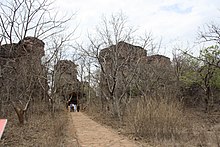Bhimbetka
| The abrises of Bhimbetka भीमबेटका पाषाण आश्रय |
|
|---|---|
|
UNESCO world heritage |
|

|
|
| A picture in the rock niches |
|
| National territory: |
|
| Type: | Culture |
| Criteria : | (iii) (v) |
| Surface: | 1.893 ha |
| Reference No .: | 925 |
| UNESCO region : | Asia and Pacific |
| History of enrollment | |
| Enrollment: | 2003 (session 27) |
Bhimbetka is an archaeological site in the Indian state of Madhya Pradesh with stone age rock paintings . The paintings on rock overhangs ( abrises ), which are up to 9000 years old , were discovered as early as 1888, but were not scientifically described until the 1950s. Bhimbetka is the oldest rock carving site on the Indian subcontinent. The area has been declared a World Heritage Site by UNESCO .
location
The rock caves of Bhimbetka are 45 kilometers south of Bhopal on the southern edge of the Vindhya Mountains . Further south follow the mountain ranges of the Satpura Mountains . The entire area is covered by thick forests and bushes. There are plenty of year-round water sources, natural tunnels, and significant similarities with similar rock art sites, such as Kakadu National Park in Australia.
Bhimbetka is mentioned in the Indian epic Mahabharata as the place of residence of the hero Bhima .
discovery
As detailed in the UNESCO decision, Bhimbetka was first mentioned as a Buddhist site in Indian archaeological records based on information from local Adivasi . Much later, on the train journey to Bhopal , VS Wakankarl saw rock formations similar to those he had seen in Spain and France . He visited the area with a team of archaeologists and discovered several prehistoric rock grottos.
Since then, more than 700 such grottos have been identified. Of these, 243 are in the Bhimbetka group and 178 in the Lakha Juar group. Archaeological research revealed a continuous settlement by Stone Age cultures (from the late Middle Paleolithic ( Acheuléen ) to the Middle Stone Age ) as well as the oldest stone walls and floors in the world. The oldest rock carvings are believed to be from the Mesolithic. A rough dating of the finds was carried out, while a detailed chronology is still pending.
Rock paintings
The rock grottos and caves of Bhimbetka have numerous interesting paintings that vividly depict the life of the cave dwellers and their natural surroundings. One of the rocks, popularly known as the "zoo rocks", depicts elephants , sambars , bison and deer . Paintings on another rock show a peacock , a snake , a deer and a sun . On another rock there are two elephants with tusks. In one of the caves, a bison is shown chasing a hunter while his companions stand by helplessly. This collection of prehistoric paintings also includes more recent hunting scenes with hunters carrying bows and arrows, swords and shields. In another scene you see riders together with archers. One of the earliest depictions of an hourglass drum is of musical historical importance . Scenes of dancers embracing each other with outstretched arms belong in a ritual context.
The paint is believed to have been made from colored soil, vegetable dyes, roots and animal fats. The brushes were made of vegetable fibers.
Web links
- Entry on the UNESCO World Heritage Center website ( English and French ).
- Prehistoric Art: Bhimbetka. vm.kemsu.ru
- Places to see: Amazing Bhimbetka. mptourism.com
- KL Kamat: Cave Paintings of India: Prehistoric Paintings of Bhimbetka. kamat.com
Coordinates: 22 ° 55 ′ 40 ″ N , 77 ° 35 ′ 0 ″ E


